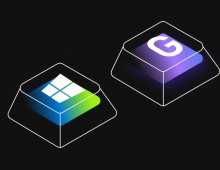
Microsoft Sees Growth Beyond The Desktop With Windows 10
Microsoft's annual corporate report to the SEC incudes the company's expectations and groeth oportumities with the release of Windows 10. "Our ambition for Windows 10 is to broaden our economic opportunity through three key levers: an original equipment manufacturer ('OEM') ecosystem that creates exciting new hardware designs for Windows 10; our own commitment to the health and profitability of our first-party premium device portfolio; and monetization opportunities such as services, subscriptions, gaming, and search," reads the report.
In a shrinking PC market, Microsoft's "new hardware designs" from hardware manufacturers like HP and Dell could mean that the company is moving to products beyond the desktop, such as smartphones, tablets, and other kind of devices.
Microsoft's "first party" premium device portfolio could inlcude devices such as the succesful Surface tablet product line or new the Lumia flagship Windows Phones, despite their weak market presence so far.
Windows 10 launched with the key promise of creating a user experience that transcends the phone, tablet and PC. While this should, at least in theory, help drive the appeal of Windows-based phones, the reality is that it may be too little, too late for the mobile component.
We live in a world dominated by Android and iOS – both hardware and apps. The Android and iOS platforms each offer more than one million apps but Microsoft is lacking apps and this remains their main challenge in offering a relevant third ecosystem choice for two reasons. Firstly, they are late to get new apps, being lower down in line for any developer; secondly, sometimes they are so low down that the app never comes. Think of last year’s key app, Flappy Birds. It came, got everyone hooked and vanished all without touching the Windows Phone world. And that is hardly a one-time issue: Windows Phone is lacking key apps in three top-tier categories; video, social, and gaming. In the video space, for example, Windows Phone has less than half the apps that can be found on Android and iOS, and both Amazon Instant Video and HBO GO missing.
In an effort to help boost app development, Microsoft recently launched the ability to more-easily port code from iOS over to the Windows platform. While a good step along the path, it is not necessarily the crux of the issue. Building an app is one thing; supporting it is quite another, and to justify the level of support needed (ensuring that it remains current with Android and iOS versions, for example) typically requires far more effort.
The Xbox One video-game console will also be updated with Windows 10 in order to gain some PC characteristics, while remaining a strong entertainment device.
"Monetization opportunities such as services, subscriptions, gaming, and search" should be attributed to subscription services like Microsoft Office 365 or Xbox Live, which will also work on iPhones and Androids.
Microsoft’s greatest chance of gaining mobile users is converting them from its two biggest businesses – the PC and Xbox user bases. Xbox Live is built into Windows 10 and allows multi-player gaming across multiple platforms. Further, synergy between the PC environment and mobile has significant benefits within the work environment (think unified email and related communications) which can help to drive greater interest in the mobile platform. Time will be the only tell for Microsoft to know if the changes made to Windows 10 and its new cross-device development are enough to drive up phone adoption, which in turn could create a more competitive platform for developers to invest in.
Fake emails offering Windows 10 upgrades
In the meantime, hackers are taking advantage of the Windows 10 roll out and have exploited Microsoft's offer of free upgrades for the operating system.
Researchers at Cisco Systems are warning about a wave of bogus spam emails with malicious attachments, labeled as if they're legitimate copies of the new program.
The attachments contain a "ransomware" program that, when opened, locks all the data on a computer and demands payment to release them.
The emails are designed to look like an official upgrade notice from Microsoft, but several words have random, out-of-place letters and punctuation.





















